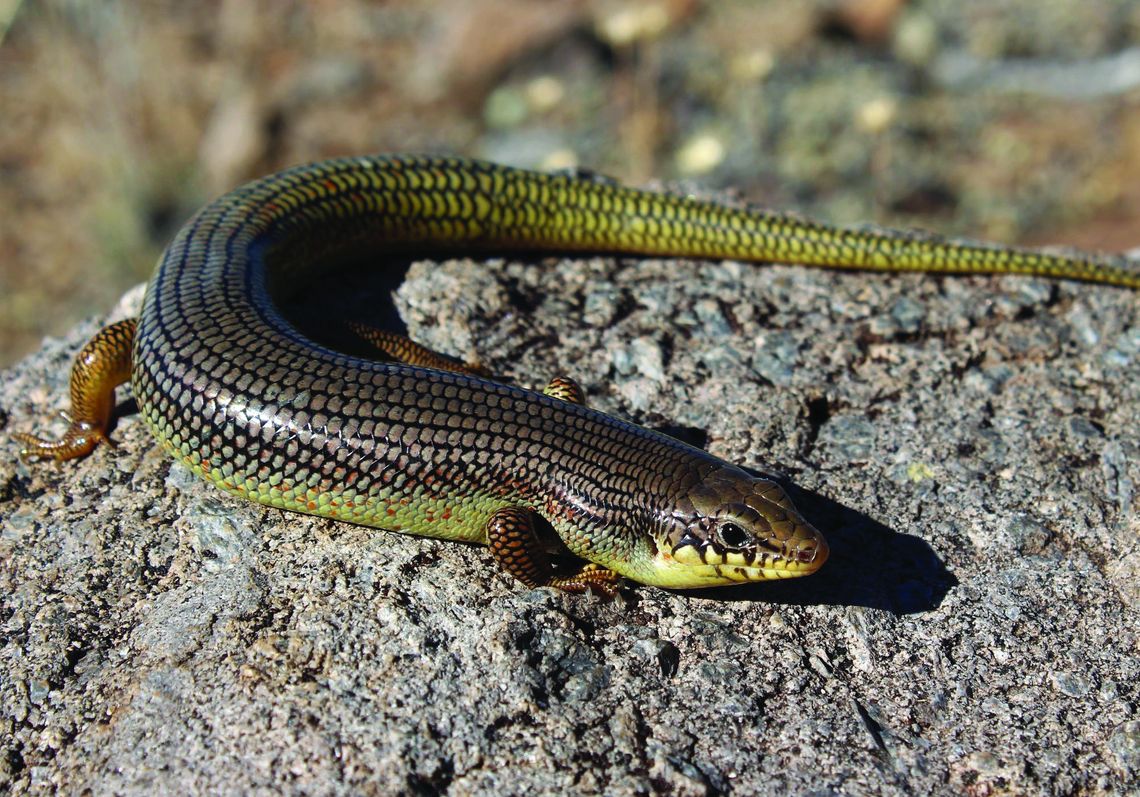The Great Plains Skink (Plestiodon [Eumeces] obsoletus) is one of eight species of skinks that live in Texas, and it has the largest area of distribution. It occurs throughout the western ¾ of the state; roughly defined occurring west of an imaginary line drawn from the DFW region southward. Outside of Texas, it occurs northward to southern Nebraska, westward to central Arizona, and southward to the central plateau regions of Mexico.
The habitats that this sleek lizard prefers are the grasslands and prairies of the Panhandle that have small rocky areas and other surface debris under which it can hide. It can also be observed in rocky areas in the arid to semi-arid sandy regions of the Trans-Pecos and Edwards Plateau eco-regions.
The Great Plains Skink is an elongate lizard with tiny legs and a long tail. This species is the largest skink that inhabits this state (as well as the United States) with adults reaching a total length of almost fourteen inches, although the average is between six and nine inches. As with all species of this genus, the scales are so slick and shiny that the lizard at first glance appears to be wet. However, like other reptiles, the skin is completely dry and not slimy at all.
The background coloration on the body and tail of adults can be various shades of tan, brown, or even yellow with dark flecks on the outside edges of each scale. The belly is patternless and is buff in coloration. Juveniles look contrastingly different from the adults, with black bodies and bright blue tails. Many youngsters will also have random amounts of white or orange on the black head. As the young animal matures, it begins to change from its juvenile coloration to the one that it will have as an adult – this process is known as an ontogenetic change.
Like other reptile species, the Great Plains Skink is cold-blooded”, or ectothermic. This means that they do not generate heat from the inside of their body, as mammals and birds do, but rather are dependent on outside sources for heating and cooling. They are active throughout the day in the spring and fall, adjusting their schedules to the morning and afternoon hours during the heat of the summer.
This species of lizard has a very generalized diet. Its preferred choice of food is small beetles, although it will also feed on other small invertebrates such as crickets, grasshoppers, and ants. In captivity it has been known to feed on small mice.
The Great Plains Skink is oviparous, which is a fancy way of saying that it lays eggs. After emerging from the winter-long brumation period (reptiles do not hibernate in the true sense of the word), males will search out females to mate. After mating, the female will lay anywhere from five to twenty-five eggs in moisture retaining soil. The female will remain in the nest area for the entire incubation period, warding off any small predators that would utilize her eggs to fill their appetite. After approximately two months of incubation, the brightly colored 2 inch long young emerge prepared to fend for and care for themselves.
Despite living in these relatively dry areas, this skink must have moist conditions in its microhabitat to thrive, and the way it retains this moisture is by spending vast amounts of time either underground or under debris. For this reason, many people have never had the opportunity to encounter this relatively common lizard in the wild.
When threatened, the tail of this species can be discarded from the body rather easily, spasming enough to distract a would-be predator while the animal itself escapes to safety. This process is known as autotomization. It is also a difficult animal to grasp, utilizing its smooth scales to writhe and twist away from its captor.





















